|
|
|
[GRAVURE] [JOYAU]. CURTIS (Atherton)
L'oeuvre gravé de Amédée Joyau.
Paris, Prouté, 1938. In-4, broché, non paginé, frontispice, catalogue de 135 œuvres, reproduites en noir. Tirage à 300 exemplaires.
Referencia librero : 564366

|
|
|
[GRAVURE] BOUVY (Eugène)
La gravure de portraits et d'allégories.
Paris et Bruxelles, G. Van Oest, 1929. In-4 broché, couv. rempliée, 87 pp., LXXII planches en héliotypie, présentant 108 gravures.
Referencia librero : 564371
|
|
|
[GRAVURE] CALABI (Augusto)
La gravure italienne au XVIIIe siècle.
Paris, G. Van Oest, 1931. In-4 broché, couv. rempliée, 74 pp., 84 planches en héliotypie
Referencia librero : 564372
|
|
|
[GRAVURE] DARBOT (Jean)
Charles Favet (Reims 1899-Troyes 1982). Graveur sur bois (Reims 1899 - Troyes 1982)
Troyes, 1e novembre 2004. In-4 broché, couverture en rhodoïd transparent, non paginé, nombreuses illustrations en N/ B et en couleurs.
Referencia librero : 580533
|
|
|
[GRAVURE] DELABORDE (Henri)
Le département des estampes à la bibliothèque nationale.
Paris E. Plon et Cie, Imprimeurs-Editeurs rue Garancière, 1875. In-12, demie basane rouge, dos lisse, doubles filets dorés bordant le titre, plats de papier marbré, gardes de papier granité, [1]f. bl., faux titre, titre, 442 pp., [2]f. bl.
Referencia librero : 506668
|
|
|
[GRAVURE] FRANÇOIS (Philippe)
Dreux sur Blaise.
Dreux, Atelier de taille-douce, 1982. Grand in-8, en feuilles sous couv. rempliée cartonnée, non paginé, 12 gravures sous serpentes. Tirage à 68 exemplaires, un des 58 sur vélin blanc Van Gelder, signé par l’artiste et l’auteur.
Referencia librero : 569471
|
|
|
[Gravure] KURHAJEC (Joseph.A).
Squelette.
Gravure originale sur Linoléum rehaussée à la gouache. Dimensions: 39 x 35 cm. Épreuve d'artiste, signée et datée "2011".
Referencia librero : 715
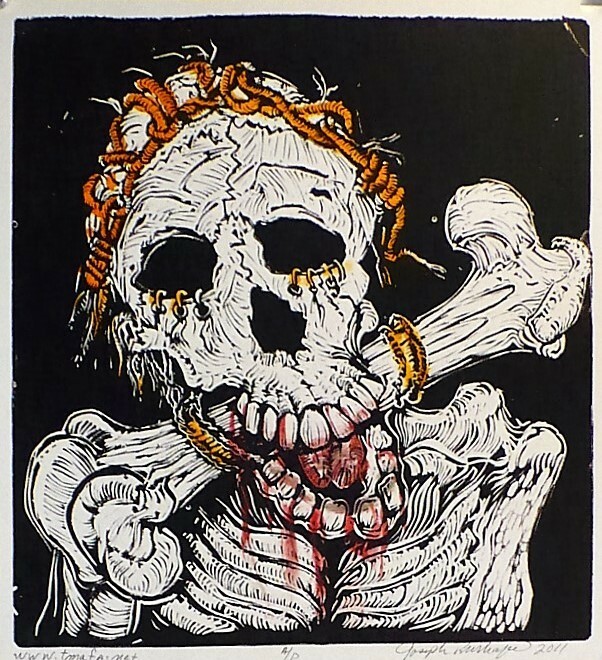
|
|
|
[Gravure] KURHAJEC (Joseph.A).
Squelette.
Gravure originale sur Linoléum rehaussée à la gouache. Dimensions: 39 x 35 cm. Épreuve d'artiste, signée et datée "2011".
Referencia librero : 715

|
|
|
[Gravure] KURHAJEC (Joseph.A).
Warmonger. Vote Against Bush.
Gravure originale sur Linoléum imprimée sur une feuille du quotidien américain "Herald Tribune" du 2 avril 1988. Dimensions: 58 x 38 cm. Épreuve d'artiste. Signée à la mine de plomb.
Referencia librero : 717
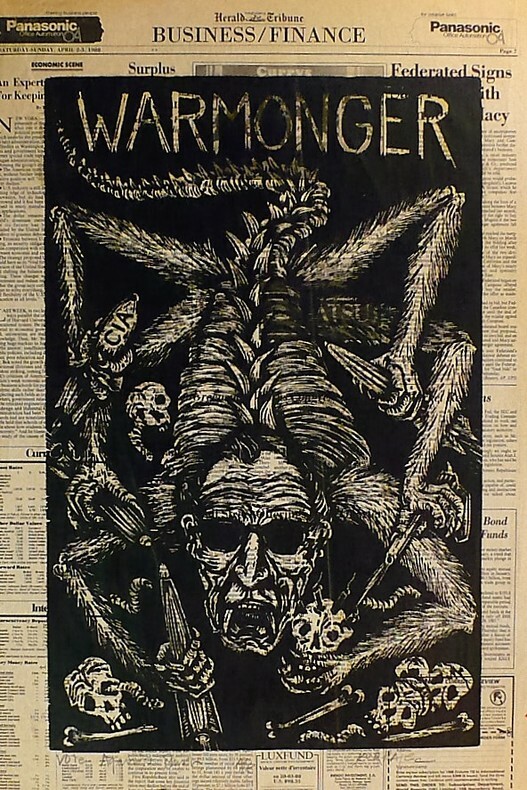
|
|
|
[Gravure] KURHAJEC (Joseph.A).
Warmonger. Vote Against Bush.
Gravure originale sur Linoléum imprimée sur une feuille du quotidien américain "Herald Tribune" du 2 avril 1988. Dimensions: 58 x 38 cm. Épreuve d'artiste. Signée à la mine de plomb.
Referencia librero : 717

|
|
|
[GRAVURE] WILLEM
LE FUMEUR
Éditions lLe Petit Jaunais. Lithographie originale sur papier BFK Rives. Dim: 50 x 32,5 cm. Tirée à 18 exemplaires. Justifiée et signé par l'artiste à la mine de plomb.
Referencia librero : 2031
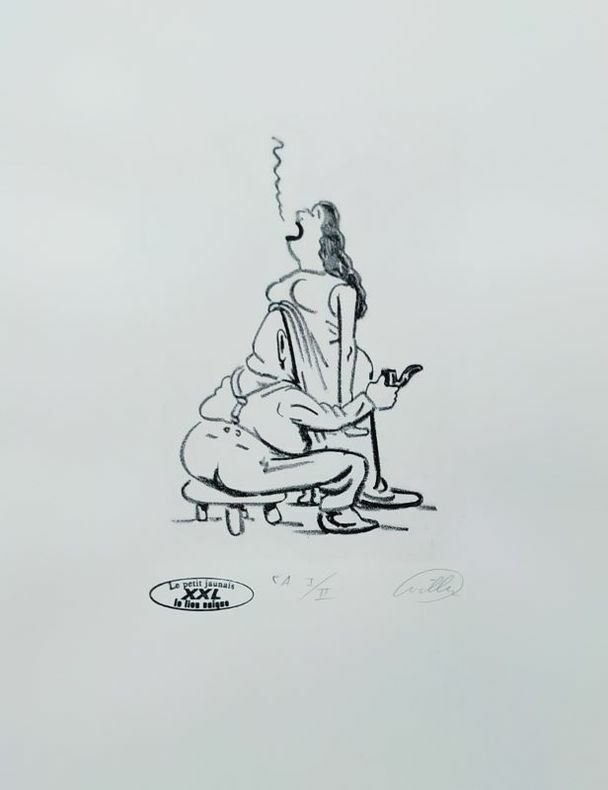
|
|
|
[GRAVURE] WILLEM
LE FUMEUR
Éditions lLe Petit Jaunais. Lithographie originale sur papier BFK Rives. Dim: 50 x 32,5 cm. Tirée à 18 exemplaires. Justifiée et signé par l'artiste à la mine de plomb.
Referencia librero : 2031

|
|
|
[Grétry, André-Ernest-Modeste].
Portrait. [Paris, Geille, frühes 19. Jahrhundert].
280 x 195 mm. Kolorierter Kupferstich von Amadée Geille nach Jean-Baptiste Isabey (1767-1855). Der französische Komponist Grétry (1741-1813) wird an seinem Schreibtisch sitzend und schreibend abgebildet.
|
|
|
[GUÉRARD (Henri-Charles)]
[Estampe]. "Un gueux de Rembrandt, par X... ". Eau-forte originale non signée.
Paris, Paris à l'Eau-forte, avril 1876. 4,4 x 10,8 cm + marges.
Referencia librero : 26423
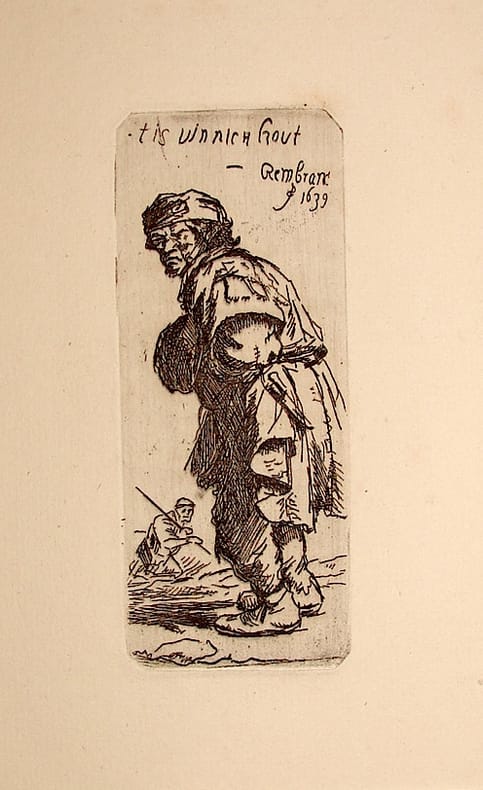
|
|
|
[Handzeichnungen].
Detailansichten einer Kathedrale. O. O., [ca. 1832].
3 Bleistiftzeichnungen (230 x 285 - 235 x 365 mm), 1 Ölzeichnung (190 x 200 mm) und 1 Druckgraphik (225 x 305 mm). Wasserzeichen teils "J. Whatman 1832". Unter 3 Passepartouts. Hübsche, sehr sorgfältig ausgeführte Studien einiger Grabplatten in einer nicht ermittelten gotischen Kathedrale, darunter die eines Bischofs sowie eines wohl adeligen Ehepaars (letztere datiert 1639). Wohl Vorzeichnungen zu einer Malerei, dazu ein handschriftlicher Kommentar: "Der Stein sehr warm und die Wappen kalte Glanzlichter". Die Druckgraphik zeigt den Kirchenraum mit einem von einer Säule teilweise verdeckten Epitaph und zwei Rosettenfenstern. - Wohlerhalten.
|
|
|
[Hippocrate (0460-0377 av. J.-C.)] - Foès Anuce (1528-1595) ou Anutius Foesius.
Oeconomia Hippocratis, alphabeti serie distincta. In qua dictionum apud Hippocratem omnium, præsertim obscuriorum, usus explicatur, & velut ex amplissimo penu de promitur : ita ut Lexicon Hippocrateum merito dici possit.
Francfort, Imprimerie André Wechel [ses successeurs Jean I Aubry et Claude de Marne], 1588, in-folio, plein vélin souple à rabats d’époque, dos lisse avec titre manuscrit, 3 ff. blancs – Page de Titre, illustrée de la belle marque d’imprimeur d’A. W. « à l’enseigne du Cheval Volant (ou Pégase) » héritée de son père l’imprimeur parisien Chrétien Wechel, et portant au dos, le portrait gravé de l’auteur en médaillon par Pierre Woeiriot (1532-1599), suivie de 3 ff. « Préface » - 694 pp. – 1 f. n.c. avec la marque d’imprimeur répétée au dos – 1 f. blanc. Edition bilingue en grec et latin imprimée sur deux colonnes. Premiers travaux publiés par le médecin et helléniste Anuce Foës sur l’œuvre d’Hippocrate. Ces commentaires conçus comme un index des termes obscurs contenus dans les manuscrits retranscrits depuis l’antiquité et leurs interprétations, illustrent la haute érudition de l’auteur et la rigueur scientifique qu’il s’est imposé pour l’établissement des œuvres complètes publiées en 1595 chez le même éditeur. Cette édition des Œuvres d’Hippocrate « est fort estimée et a sa place marquée dans toutes les bibliothèques médicales » et elle doit être jointe à ces premiers commentaires ou Index de lecture. BRUNET II – 1315 & III – 170. Bel exemplaire, à pleine marge, relié dans un beau vélin souple du temps. Défauts usuels, petites salissures et pliures à la reliure, les lacets coupés ras. Mouillure généralement claire dans la marge supérieure du texte, une autre, claire aussi, mais plus intermittente dans la marge inférieure ; quelques brunissures ou petites rousseurs éparses, très peu de ff. entièrement brunis (une dizaine tout au plus), l’aspect général n’en est pas affecté. Caractères légèrement frottés sur un feuillet. Provenance manuscrite sur la page de titre « Braconnier » et annotations manuscrites, au dos du dernier feuillet blanc en tête, et dans les marges du texte. Cf : Micheline Callanquin Wajsberg. Anuce Foës, médecin à Metz au XVIème siècle. Sciences pharmaceutiques. 2015.
Referencia librero : SHL-34

|
|
|
[HIROSHIGE]. BOUQUILLARD (J.)
Le Tôkaido de Hiroshige.
P., Bibliothèque de l’Image – BnF, 2002. In-4 obl., broché, couv. ill., 96 pp., ill. en couleurs.
Referencia librero : 544173
|
|
|
[HISTOIRE] - BOUCHOT (Henri)
Le cabinet des estampes de la bibliothèque nationale. Guide du lecteur et du visiteur. Catalogue général et raisonné des collections qui y sont conservées.
Paris, Dentu, s.d. (vers 1900); in-8, 392 pp., broché. État moyen.
|
|
|
[HISTOIRE] - BOUCHOT (Henri)
Le cabinet des estampes de la bibliothèque nationale. Guide du lecteur et du visiteur. Catalogue général et raisonné des collections qui y sont conservées.
Paris, Dentu, s.d. (vers 1900) ; in-8, 392 pp., broché. État moyen.
Referencia librero : C3197
|
|
|
[Hl. Hyacinth.] Baron, Marcin.
Sanctus Iacinctus Polonus. De familia comitum Odrouos, S. Dominici socius et discipulus, et Ordinis Praedicatorum primus in septentrione fundator. In Sanctorum catalogo adscriptus à S.mo D. N. Clemente VIII. Pont. Max. die 17 mensis Aprilis, anno dni. 1594. Köln, Peter Overradt, 1605.
Kupferstich, ca. 210 x 308 mm. Alt auf Trägerpapier aufgezogen. Seltener Stich mit Szenen aus dem Leben des Hl. Hyacinth (Jacek Odrowaz), Begründer des Dominikanerordens in Polen und Patron Litauens. Seine Missionsreise führte Hyazinth auch nach Friesach (Kärnten), wo er 1221 das erste Dominikanerkloster im deutschen Sprachraum gründete. - Der polnische Maler Martin Baron aus dem galizischen Jaroslaw war wahrscheinlich in Deutschland tätig. "Er malte Heiligenbilder, nach welchen Peter Overadt in Köln zwei 1605 und 1606 gestochen hat, den hl. Stanislaus Kostka und den hl. Hyacinth darstellend. Weitere Nachrichten über ihn fehlen gänzlich" (Thieme/B.). - Gleichmäßig stärker gebräunt; Spuren alter Faltung; einige Wurmspuren, teils auch das Bild betreffend. Residuum der Sammlung Sir Thomas Phillipps (1792-1872). Thieme/Becker II, 516.

|
|
|
[Hohenzollern].
Vier Idealportraits der frühen Grafen von Zollern. O. O., Ende des 16. Jhs.
Jeweils ca. 215 x 336 mm. Aquarell bzw. Gouache mit Goldhöhung auf Papier. Auf Fälzen unter Passepartout montiert. Vier wohl noch dem 16. Jahrhundert angehörende Idealbildnisse aus einer Porträtserie der frühen Grafen von Zollern, wie sie um 1560 Basilius Herold im Auftrag von Karl I. von Hohenzollern prägte und die Frühneuzeit hindurch weitgehend akzeptiert blieb. "Da die Grafen von Zollern erst 1061 mit Burchard ins Licht treten und erst [... Friedrich III.] die Würde eines Burggrafen von Nürnberg erwarb, handelt es sich um ein Produkt späthumanistischer Geschichtsklitterung. Der Zollerschen Hauschronik zufolge war die entsprechende historische Forschung ein Gemeinschaftswerk Graf Karls I. aus der schwäbischen Linie (1516-76) und des Historikers Johann Basilius Herold. Damals müssen auch die Idealbildnisse der ersten Grafen geschaffen worden sein, die sich formal mit rekonstruierten Ahnenreihen, etwa der Wittelsbacher, aus dieser Zeit vergleichen lassen" (Haus der bayerischen Geschichte, online). - Es liegen vor: Danko (840), der angebliche Sohn des fingierten Stammherrn Tassilo, Rudolf (892), Friedrich I. (980) und Eitel Friedrich II. (1273). Die Grafen werden jeweils in Prachtrüstung unter einem Säulenbogen dargestellt; an den Säulen prangen in hübscher Gouache das Hauswappen der Zollern sowie das der jeweiligen Ehegemahlin (von Cilli, von Rieneck, von Hohenberg und von Schlüsselberg). In einer Kartusche unter dem Portrait jeweils eine mehrzeilige handschriftliche Beschreibung des Abgebildeten nebst Nennung der Ehegemahlin. - Hübsche, wohlerhaltene Folge.
|
|
|
[HOKUSAI] - BOLLER (Willy)
Hokusa•, un maitre de l'estampe japonaise.
In-4, 22p. Edition originale. Adaptation française de Gustave Roud. Avec 86 reproductions, dont une vingtaine en couleurs. Bel album. En parfaite condition.
|
|
|
[Hugo, Victor]. - Walery (i. e. Comte Stanislaw Julian Ostrorog), Lithuanian-born photographer (1830-1890).
Woodburytype print on paper. N. p., c. 1880.
234:174 mm (size of plate), mounted on cardboard (330:250 mm).

|
|
|
[India - Mission]. Müller, Johann Sebastian (John Miller).
Herr Aaron National Land-Prediger unter den Heidnischen Malabaren in Ost-Indien. Nuremberg, bei J. Trautner, ca. 1740.
Engraving in original hand-colour. 16 x 13 cm (sheet dimensions: 30 x 21 cm). Matted. A rare engraving showing the Indian priest Aaron, the first converted native preacher of Malabar, dressed in white cloth and presenting to the viewer two pages from the Acts of the Apostles in Tamil. The Tamil Bible translation was famously published in 1713 by the Saxon missionary Bartholomaeus Ziegenbalg, who had been posted to the Danish colony of East India (Malabar) in the early 18th century. A nearly half-page letterpress text below the engraving elaborates on the conversion and life of Aaron, who was born ca. 1699, baptised in 1718, and ordained in 1733. - The engraver and botanist J. S. Müller (1715 - ca. 1792), known as John Miller in Britain, was born in Nuremberg, where he trained under Johann Christoph Weigel. He came to England in 1744 with his brother Tobias - an engraver of architecture - and remained there the rest of his life, producing several important botanical works and apparently also forging several oil paintings for London's appreciative art market. - Traces of folds; insignificant duststains to margins.
|
|
|
[India]. - Delhi: Jama Masjid.
"Jumma Musjid Delhi". Watercolour on cardboard. No place, [ca 1920].
Signed "A. Alintor" (?). 205 x 460 mm. An imaginative rendering of the Masjid-i Jahan-Numa (World-reflecting Mosque) in Delhi, shown here in the midst of a desert, with camels and bedouins in the foreground. - Mounted on cardboard; two small tears to lower edge.
|
|
|
[INDOCHINE] - ESTAMPES (Louis d').-
Sur les bords du fleuve rouge. 2e édition.
Tours, Mame, 1885, in 8° broché, 240 pages ; couverture illustrée fanée avec petit manque angulaire).
Referencia librero : 57476
|
|
|
[INDOCHINE] - ESTAMPES (Louis d').-
Sur les bords du fleuve Rouge. 4e édition.
Tours, Mame, 1892, in 8° relié demi-basane brune, dos lisse orné de filets dorés, 240 pages.
Referencia librero : 70147
|
|
|
[Innenarchitektur] - Machatschek, Adolf.
Sammlung von 20 Entwurfszeichnungen für Ausstellungs- und Geschäftsmöblierungen. Wien, um 1870.
Federzeichnungen, tw. aquarelliert und mit Goldfarbe gehöht, auf 10 originale Untersatzkartons montiert. Handsigniert und mit Namensstempel. Folio. Die Entwürfe des "k. k. Professors und Architekt Dr. Adolf Machatschek" zeigen Ausstellungsmöblierungen diverser Wiener Firmen für deren Produktpräsentationen auf Welt- und Gewerbeausstellungen zwischen 1867 und 1872, darunter Portale für "die Ausstellung in Paris 1867", für Lehrmittel, die "Gypsbrüche Schottwien", für Hardtmuth in Budweis, für einen Tabak-Pavillon, Vitrine für Friseurarbeiten etc.
|
|
|
[ISABEY]. CURTIS (Atherton)
Catalogue de l'œuvre lithographié de Eugène Isabey.
Paris, Prouté, s.d. [1939]. In-4, broché, non paginé, frontispice, catalogue de 109 œuvres, reproduites en noir (à l’exception de l’avant-dernière, non retrouvée), index. Tirage à 300 exemplaires.
Referencia librero : 564322

|
|
|
[Italie]:
Album souvenir d’Italie. Pradier Officier des Zouaves à sa soeur.
[vers 1840]. In-folio à l'italienne, dos en toile, plats de papier moiré bleu nuit, titre doré au premier plat (coins légèrement frottés).
Referencia librero : 4550
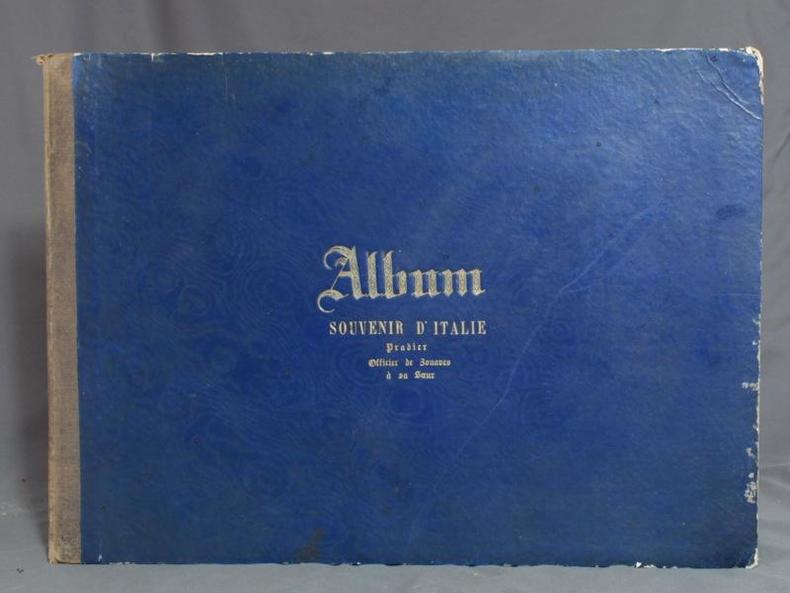
|
|
|
[Jackson, Herbert J.].
[European Hand Firearms of the Sixteenth, Seventeenth & Eighteenth Century:] "Very Fine Example of a XVIth Century Wheel-Lock Pistol." [ORIGINAL COLLOTYPE PRINT].
Original single-sheet collotype print of fine quality. Overall size ca. 30 x 24 cm. Very good. First, limited edition, printed on heavy paper with very wide margins. Collotype is one of the most accurate and attractive methods of photomechanical tonal printing processes. Highly skilled and expensive process, it cannot produce more than a limited number of impressions. It has been used for single-sheet prints and luxury portfolios, and since the 1950s has been abandoned by all except a few small specialist firms. Preserved in pH-balanced, acid-free archival paper.
|
|
|
[Jackson, Herbert J.].
[European Hand Firearms of the Sixteenth, Seventeenth & Eighteenth Century:] "Pair of Brescian Wheel-Lock Pistols, Chiselled Mounts, and Pair of Brescian Wheel-Lock Pistols, Pierced and Chiselled Mounts." [ORIGINAL COLLOTYPE PRINT].
Original single-sheet collotype print of fine quality. Overall size ca. 30 x 24 cm. Very good. First, limited edition, printed on heavy paper with very wide margins. Collotype is one of the most accurate and attractive methods of photomechanical tonal printing processes. Highly skilled and expensive process, it cannot produce more than a limited number of impressions. It has been used for single-sheet prints and luxury portfolios, and since the 1950s has been abandoned by all except a few small specialist firms. Preserved in pH-balanced, acid-free archival paper.
|
|
|
[Jackson, Herbert J.].
[European Hand Firearms of the Sixteenth, Seventeenth & Eighteenth Century:] "Wheel-Lock Gun, Stock Overlaid with Ivory." [ORIGINAL COLLOTYPE PRINT].
Original single-sheet collotype print of fine quality. Overall size ca. 30 x 24 cm. Very good. First, limited edition, printed on heavy paper with very wide margins. Collotype is one of the most accurate and attractive methods of photomechanical tonal printing processes. Highly skilled and expensive process, it cannot produce more than a limited number of impressions. It has been used for single-sheet prints and luxury portfolios, and since the 1950s has been abandoned by all except a few small specialist firms. Preserved in pH-balanced, acid-free archival paper.
|
|
|
[Jackson, Herbert J.].
[European Hand Firearms of the Sixteenth, Seventeenth & Eighteenth Century:] "Finely Chiselled Brescian Wheel-Lock, and a Wheel-Lock Sporting Gun, Dutch." [ORIGINAL COLLOTYPE PRINT].
Original single-sheet collotype print of fine quality. Overall size ca. 30 x 24 cm. Very good. First, limited edition, printed on heavy paper with very wide margins. Collotype is one of the most accurate and attractive methods of photomechanical tonal printing processes. Highly skilled and expensive process, it cannot produce more than a limited number of impressions. It has been used for single-sheet prints and luxury portfolios, and since the 1950s has been abandoned by all except a few small specialist firms. Preserved in pH-balanced, acid-free archival paper.
|
|
|
[Jackson, Herbert J.].
[European Hand Firearms of the Sixteenth, Seventeenth & Eighteenth Century:] "Brescian Wheel-Lock Pistol, Pierced and Chiselled Mounts." [ORIGINAL COLLOTYPE PRINT].
Original single-sheet collotype print of fine quality. Overall size ca. 30 x 24 cm. Very good. First, limited edition, printed on heavy paper with very wide margins. Collotype is one of the most accurate and attractive methods of photomechanical tonal printing processes. Highly skilled and expensive process, it cannot produce more than a limited number of impressions. It has been used for single-sheet prints and luxury portfolios, and since the 1950s has been abandoned by all except a few small specialist firms. Preserved in pH-balanced, acid-free archival paper.
|
|
|
[Jackson, Herbert J.].
[European Hand Firearms of the Sixteenth, Seventeenth & Eighteenth Century:] "Brescian Sporting Gun with Finely Chiselled and Pierced Mounts." [ORIGINAL COLLOTYPE PRINT].
Original single-sheet collotype print of fine quality. Overall size ca. 30 x 24 cm. Very good. First, limited edition, printed on heavy paper with very wide margins. Collotype is one of the most accurate and attractive methods of photomechanical tonal printing processes. Highly skilled and expensive process, it cannot produce more than a limited number of impressions. It has been used for single-sheet prints and luxury portfolios, and since the 1950s has been abandoned by all except a few small specialist firms. Preserved in pH-balanced, acid-free archival paper.
|
|
|
[Jackson, Herbert J.].
[European Hand Firearms of the Sixteenth, Seventeenth & Eighteenth Century:] "XVIth Century Wheel-Lock Pistols." [ORIGINAL COLLOTYPE PRINT].
Original single-sheet collotype print of fine quality. Overall size ca. 30 x 24 cm. Very good. (Small spot or two.) First, limited edition, printed on heavy paper with very wide margins. Collotype is one of the most accurate and attractive methods of photomechanical tonal printing processes. Highly skilled and expensive process, it cannot produce more than a limited number of impressions. It has been used for single-sheet prints and luxury portfolios, and since the 1950s has been abandoned by all except a few small specialist firms. Preserved in pH-balanced, acid-free archival paper.
|
|
|
[Jackson, Herbert J.].
[European Hand Firearms of the Sixteenth, Seventeenth & Eighteenth Century:] "Fine Example of Early Brescian Pistol with Flattened Butt." [ORIGINAL COLLOTYPE PRINT].
Original single-sheet collotype print of fine quality. Overall size ca. 30 x 24 cm. Very good. First, limited edition, printed on heavy paper with very wide margins. Collotype is one of the most accurate and attractive methods of photomechanical tonal printing processes. Highly skilled and expensive process, it cannot produce more than a limited number of impressions. It has been used for single-sheet prints and luxury portfolios, and since the 1950s has been abandoned by all except a few small specialist firms. Preserved in pH-balanced, acid-free archival paper.
|
|
|
[Jackson, Herbert J.].
[European Hand Firearms of the Sixteenth, Seventeenth & Eighteenth Century:] "Four-Barrel Revolving Pistol and Double-Barrel (Side by Side), Both Metal Butted." [ORIGINAL COLLOTYPE PRINT].
Original single-sheet collotype print of fine quality. Overall size ca. 30 x 24 cm. Very good. (Light marginal finger soiling.) First, limited edition, printed on heavy paper with very wide margins. Collotype is one of the most accurate and attractive methods of photomechanical tonal printing processes. Highly skilled and expensive process, it cannot produce more than a limited number of impressions. It has been used for single-sheet prints and luxury portfolios, and since the 1950s has been abandoned by all except a few small specialist firms. Preserved in pH-balanced, acid-free archival paper.
|
|
|
[Jackson, Herbert J.].
[European Hand Firearms of the Sixteenth, Seventeenth & Eighteenth Century:] "Metal-Butted Single- and Double-barrel (Under and Over) Pistols, and Pair of Metal-Butted Pistols with Barrels Chiselled, Each with Different Design." [ORIGINAL COLLOTYPE PRINT].
Original single-sheet collotype print of fine quality. Overall size ca. 30 x 24 cm. Very good. First, limited edition, printed on heavy paper with very wide margins. Collotype is one of the most accurate and attractive methods of photomechanical tonal printing processes. Highly skilled and expensive process, it cannot produce more than a limited number of impressions. It has been used for single-sheet prints and luxury portfolios, and since the 1950s has been abandoned by all except a few small specialist firms. Preserved in pH-balanced, acid-free archival paper.
|
|
|
[Jackson, Herbert J.].
[European Hand Firearms of the Sixteenth, Seventeenth & Eighteenth Century:] "Group of Four Metal-Butted Pistols, Single Barrels, Two with Secret Folding Triggers." [ORIGINAL COLLOTYPE PRINT].
Original single-sheet collotype print of fine quality. Overall size ca. 30 x 24 cm. Very good. First, limited edition, printed on heavy paper with very wide margins. Collotype is one of the most accurate and attractive methods of photomechanical tonal printing processes. Highly skilled and expensive process, it cannot produce more than a limited number of impressions. It has been used for single-sheet prints and luxury portfolios, and since the 1950s has been abandoned by all except a few small specialist firms. Preserved in pH-balanced, acid-free archival paper.
|
|
|
[Jackson, Herbert J.].
[European Hand Firearms of the Sixteenth, Seventeenth & Eighteenth Century:] "Cannon Barrel Holster Pistols, and Cannon Barrel Holster Pistols with Barrel Attached by Swivel Ring." [ORIGINAL COLLOTYPE PRINT].
Original single-sheet collotype print of fine quality. Overall size ca. 30 x 24 cm. Very good. First, limited edition, printed on heavy paper with very wide margins. Collotype is one of the most accurate and attractive methods of photomechanical tonal printing processes. Highly skilled and expensive process, it cannot produce more than a limited number of impressions. It has been used for single-sheet prints and luxury portfolios, and since the 1950s has been abandoned by all except a few small specialist firms. Preserved in pH-balanced, acid-free archival paper.
|
|
|
[Jackson, Herbert J.].
[European Hand Firearms of the Sixteenth, Seventeenth & Eighteenth Century:] "Single-Barrel Pistol of Unusual Length, and Group of Four Fine Pistols, Stocks Mounted and Inlaid with Silver." [ORIGINAL COLLOTYPE PRINT].
Original single-sheet collotype print of fine quality. Overall size ca. 30 x 24 cm. Very good. First, limited edition, printed on heavy paper with very wide margins. Collotype is one of the most accurate and attractive methods of photomechanical tonal printing processes. Highly skilled and expensive process, it cannot produce more than a limited number of impressions. It has been used for single-sheet prints and luxury portfolios, and since the 1950s has been abandoned by all except a few small specialist firms. Preserved in pH-balanced, acid-free archival paper.
|
|
|
[Jackson, Herbert J.].
[European Hand Firearms of the Sixteenth, Seventeenth & Eighteenth Century:] "Pair of Double-Barrel (Cannon) Pistols of Exceptional Length." [ORIGINAL COLLOTYPE PRINT].
Original single-sheet collotype print of fine quality. Overall size ca. 30 x 24 cm. Very good. (Minor marginal spotting.) First, limited edition, printed on heavy paper with very wide margins. Collotype is one of the most accurate and attractive methods of photomechanical tonal printing processes. Highly skilled and expensive process, it cannot produce more than a limited number of impressions. It has been used for single-sheet prints and luxury portfolios, and since the 1950s has been abandoned by all except a few small specialist firms. Preserved in pH-balanced, acid-free archival paper.
|
|
|
[Jackson, Herbert J.].
[European Hand Firearms of the Sixteenth, Seventeenth & Eighteenth Century:] "Two-Barrel Pistols, Under and Over, and Side by Side." [ORIGINAL COLLOTYPE PRINT].
Original single-sheet collotype print of fine quality. Overall size ca. 30 x 24 cm. Very good. First, limited edition, printed on heavy paper with very wide margins. Collotype is one of the most accurate and attractive methods of photomechanical tonal printing processes. Highly skilled and expensive process, it cannot produce more than a limited number of impressions. It has been used for single-sheet prints and luxury portfolios, and since the 1950s has been abandoned by all except a few small specialist firms. Preserved in pH-balanced, acid-free archival paper.
|
|
|
[Jackson, Herbert J.].
[European Hand Firearms of the Sixteenth, Seventeenth & Eighteenth Century:] "English Hunting Sword with Flint-Lock Pistol Attachment Finely Mounted in Silver, and English Seven-Barrel Flint-Lock [Flintlock] Revolving Pistol." [ORIGINAL COLLOTYPE PRINT].
Original single-sheet collotype print of fine quality. Overall size ca. 30 x 24 cm. Very good. First, limited edition, printed on heavy paper with very wide margins. Collotype is one of the most accurate and attractive methods of photomechanical tonal printing processes. Highly skilled and expensive process, it cannot produce more than a limited number of impressions. It has been used for single-sheet prints and luxury portfolios, and since the 1950s has been abandoned by all except a few small specialist firms. Preserved in pH-balanced, acid-free archival paper.
|
|
|
[Jackson, Herbert J.].
[European Hand Firearms of the Sixteenth, Seventeenth & Eighteenth Century:] "Pair of Single-Barrel Pistols, Well Mounted with Silver Medallions on Brass, and Pair of Spanish Pistols Fitted with Southern Italian Locks." [ORIGINAL COLLOTYPE PRINT].
Original single-sheet collotype print of fine quality. Overall size ca. 30 x 24 cm. Very good. First, limited edition, printed on heavy paper with very wide margins. Collotype is one of the most accurate and attractive methods of photomechanical tonal printing processes. Highly skilled and expensive process, it cannot produce more than a limited number of impressions. It has been used for single-sheet prints and luxury portfolios, and since the 1950s has been abandoned by all except a few small specialist firms. Preserved in pH-balanced, acid-free archival paper.
|
|
|
[Jackson, Herbert J.].
[European Hand Firearms of the Sixteenth, Seventeenth & Eighteenth Century:] "French Revolving Sporting Gun, Dated 1720." [ORIGINAL COLLOTYPE PRINT].
Original single-sheet collotype print of fine quality. Overall size ca. 30 x 24 cm. Very good. First, limited edition, printed on heavy paper with very wide margins. Collotype is one of the most accurate and attractive methods of photomechanical tonal printing processes. Highly skilled and expensive process, it cannot produce more than a limited number of impressions. It has been used for single-sheet prints and luxury portfolios, and since the 1950s has been abandoned by all except a few small specialist firms. Preserved in pH-balanced, acid-free archival paper.
|
|
|
[Jackson, Herbert J.].
[European Hand Firearms of the Sixteenth, Seventeenth & Eighteenth Century:] "Two Holster Pistols, One Well Mounted with Silver Medallions on Brass, the Other with Silver, and Hammerless Pistols, the Flint-Holder Contained within the Barrel." [ORIGINAL COLLOTYPE PRINT].
Original single-sheet collotype print of fine quality. Overall size ca. 30 x 24 cm. Very good. First, limited edition, printed on heavy paper with very wide margins. Collotype is one of the most accurate and attractive methods of photomechanical tonal printing processes. Highly skilled and expensive process, it cannot produce more than a limited number of impressions. It has been used for single-sheet prints and luxury portfolios, and since the 1950s has been abandoned by all except a few small specialist firms. Preserved in pH-balanced, acid-free archival paper.
|
|
|
[Jackson, Herbert J.].
[European Hand Firearms of the Sixteenth, Seventeenth & Eighteenth Century:] "Air Pistol, End of XVIIIth Century, and Pistol to Fire Four Charges from One Barrel." [ORIGINAL COLLOTYPE PRINT].
Original single-sheet collotype print of fine quality. Overall size ca. 30 x 24 cm. Very good. First, limited edition, printed on heavy paper with very wide margins. Collotype is one of the most accurate and attractive methods of photomechanical tonal printing processes. Highly skilled and expensive process, it cannot produce more than a limited number of impressions. It has been used for single-sheet prints and luxury portfolios, and since the 1950s has been abandoned by all except a few small specialist firms. Preserved in pH-balanced, acid-free archival paper.
|
|
|